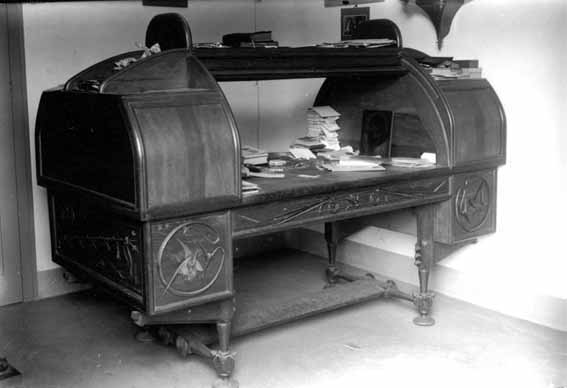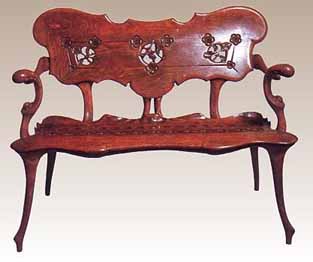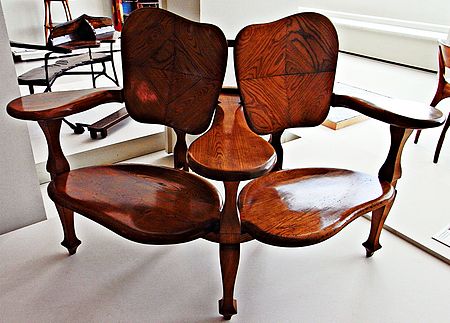It's easy to think of the Catalan architect Antoni Gaudi in stone and cement, the prominent materials of his iconic buildings, including the Sagrada Familia basilica and some of his residential buildings, such as Casa Battlo, just below, and Casa Mila, whose common nickname, La Pedrera, means "stone quarry."
The sometimes swirling shapes and spaces of his buildings (my wife used to say that they were proof that magic mushrooms weren't necessary for hallucinations) are certainly memorable, but it's worth taking a look at his way with wood, as well.
Looking through an archive of pictures made during two visits to Casa Battlo a number of years ago, I was struck by how much use he made of wood in the home he built for a prominent textile manufacturer who is said to have told Gaudi to do what he wished as long as no one else would have the like of it.
Rich ribbons of wood snake their way up staircases
The wood warms some of the spaces; in other places it is the color contrast to stark walls; it turns a stairway into an invitation to climb, and it can occasionally induce near-dizziness with its utter rejection of symmetry. Even where symmetry appears near at hand, a second look spots the differences.
An unusual form for a table that contains some classic elements
In some places there are expanses of wood, in patterned floors; in others, the wood is broken up with glass or jewel elements, and in others it draws attention to windows, and what lies outside them.
Casa Battlo was a late-in-career work for Gaudi; he was in his fifties, and turning more and more of his attention to the Sagrada Familia project. already more than twenty years under construction and behind schedule (although Gaudi is said to have told people not to worry: "My client is not in a hurry.") After Casa Battlo, he did only one more residence, Casa Mila.
That's a wood archway on an alcove for a stove; it almost blends into stone.
But early in his career, before he graduated as an architect, Gaudi was making furniture, including a massive combination rolltop desk, drafting table and file system for himself. It was destroyed during the Spanish Civil War, and only photographs are available.
 Some of his residential commissions also included furniture, such as this bench for Casa Calvet and the unusual 'Confidant' seating in Casa Battlo itself. I find it hard to say whether to call it chairs, loveseat, split bench, or what—or to imagine why anyone would want to sit together facing away from each other line that. Perhaps Gaudi shared Frank Lloyd Wright's disdain for comfort in furniture.
Some of his residential commissions also included furniture, such as this bench for Casa Calvet and the unusual 'Confidant' seating in Casa Battlo itself. I find it hard to say whether to call it chairs, loveseat, split bench, or what—or to imagine why anyone would want to sit together facing away from each other line that. Perhaps Gaudi shared Frank Lloyd Wright's disdain for comfort in furniture.
There's a replica of the Confidant at Casa Battlo; like quite a bit of Gaudi furniture, the original is in the Catalan National Museum of Art.
Gaudi is usually described as a Modernist, or a master of Art Nouveau, but it's difficult to fit him into the same frame with his contemporaries like Guimard, Horta, Otto Wagner or Wright; they and others shared a shift from previous 'classical' norms, but in many ways Gaudi is so far out, even among his closest Catalan contemporaries like Lluis Domenech i Montaner, that I really think he can only be seen as one-of-a-kind, the master of Gaudi-ism.
My own personal journey to a deep admiration of Gaudi's work in most cases and to a curiosity about his intent, what questions he was seeking to answer in his work, has been a long one. I started out thinking of him as a novelty artist, not really serious, a merry prankster of sorts. While I am still, in most cases, more drawn to Domenech i Montaner's work I have, in some way, fallen for Gaudi. Until travel opens again, though, it will have to be an affair from afar.






Comments (0)